 A shortcrust pastry pie crust | |
| Type | Pastry |
|---|---|
| Region or state | Western countries |
| Main ingredients | Fat (lard, shortening, butter or full-fat margarine), flour, water[1] |
Shortcrust is a type of pastry often used for the base of a tart, quiche, pie, or (in the British English sense) flan. Shortcrust pastry can be used to make both sweet and savory pies such as apple pie, quiche, lemon meringue or chicken pie.
A sweetened version – using butter – is used in making spritz cookies.
Shortcrust pastry recipes usually call for twice as much flour as fat by weight. Fat (as lard, shortening, butter or traditional margarine) is rubbed into plain flour to create a loose mixture that is then bound using a small amount of ice water, rolled out, then shaped and placed to create the top or bottom of a pie. Often, equal amounts of butter and lard are used to make the pastry, ensuring that the combined weight of the two fat products is still half that of the flour. The butter is employed to give the pastry a rich flavor, while the lard ensures optimum texture.
Types
- Pâte à foncer is a French shortcrust pastry that includes egg. Egg and butter are worked together with a small quantity of sugar and salt before the flour is drawn into the mixture and cold water is added to bind it.[2]
- Pâte brisée is similar to pâte à foncer, but is lighter and more delicate due to an increased quantity of butter – up to three-fifths the quantity of flour. Very often it is made with no sugar, as a savoury crust for pies.[2]
- Pâte sablée is made with more sugar, which sweetens the mix and impedes the gluten strands, creating a pastry that breaks up easily in the mouth. An alternative is a gluten-free pastry.
- Pâte sucrée has the same ingredients as pâte sablée, but the butter is creamed with the sugar and the eggs before the flour is folded in. This mixes the butter more evenly, which makes the dough puff much less, creating a more "snappy" and dry pastry, instead of the crumbly texture of the previous doughs.
Techniques
In preparing a shortcrust, the fat and flour are "cut" into each other, rather than blended, and the ingredients are kept cold. This ensures that the fat remains distinct in the crust, and when it heats during baking, steam is released, resulting in the pockets that make a flaky crust.[3] Water is only added once the fat and flour are thoroughly combined. This ensures that the flour granules are adequately coated with fat and are less likely to develop gluten.[4] This may be achieved with the use of a food processor, a specialized kitchen utensil called a pastry blender, or through various alternatives, like a pair of table knives held in one hand, or smearing the flour and fat together using the heel of the hand in a method known as fraisage.[5]
In addition to over-warming the dough, overworking it is also a hazard. Overworking elongates the gluten strands, creating a product that is tough, rather than light and crumbly or flaky. Flour made from low protein soft wheat, like cake flour, is used for pastry making because it does not become overworked and tough as easily as bread flour.
See also
References
- ↑ "Shortcrust pastry". BBC Food. Retrieved 7 June 2017.
- 1 2 Roux, Michel (2010) [First published 2008]. "Shortcrust pastries". Pastry. London: Quadrille Publishing. pp. 20–23. ISBN 978-1-84400-827-8.
- ↑ Magazine, Cook's Illustrated (2004). Baking illustrated : a best recipe classic (1st ed.). Brookline, Massachusetts. ISBN 0936184752. OCLC 54454496.
{{cite book}}: CS1 maint: location missing publisher (link) - ↑ Cheaib, Rana. Predicting Baking Performance through Evaluation of Short-crust Dough (Masters thesis). Malmö: Lund University. Archived from the original on 2018-10-09. Retrieved 2018-10-09 – via Perten Instruments.
- ↑ "What is fraisage, and how do I use it for flaky pie dough?". Retrieved 2022-01-09.